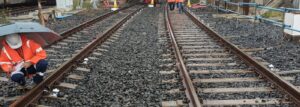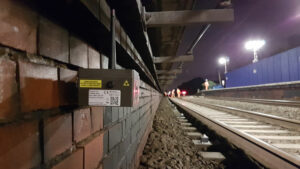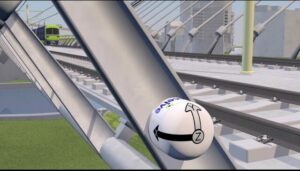New Zealand’s Main Trunk Line railway in the country’s North Island is a vital piece of infrastructure connecting capital city Wellington in the island’s south with the nation’s largest city, Auckland to the north. In operation since 1908, the 680 kilometre arterial line carries passengers, freight and livestock. It is single track in large sections, with frequent passing loops.
In Waimiha, located approximately halfway along the Main Trunk Line, a section of the railway that runs along the crest of a hill was starting to move as the soil gradually slid down into the valley. Engineers at Kiwi Rail, the company that operates the line, would carry out regular inspection, maintenance and repair work to counteract the track movements.

“During or soon after particularly wet weather the movement could be quite significant, so much so that engineers needed to walk ahead of the train to ensure it was safe for it to continue its journey,” said Corbon Laughnan, Survey Consultant for Senceive’s local distributor Aptella.
Kiwi Rail enlisted the expertise of engineering and surveying firm Vitruvius to monitor the track. With experience monitoring wind farm turbines in Australia utilising the latest wireless rail monitoring systems, Vitruvius set to work getting a similar setup for the Waimiha rail project.
“We first used the Senceive product range to monitor wind turbines, installing a wireless node on each of the four corners at the base of the column to check for any movement in the structure as there are significantly high forces coming through the column,” said Terry Hodder, a representative from Vitruvius.
Vitruvius installed nine Senceive nodes along the area of the track that needed to be monitored. The small triaxial tilt nodes are fixed to the track to enable close monitoring of the core structure without interfering with the train.
“Connecting the nodes to a gateway to enable the data to be transmitted was an interesting challenge,” explained Corbon Loughnan,
“This area of New Zealand is extremely remote and has no mobile phone signal whatsoever,” he continued. “We negotiated with a local farmer to install the gateway on his farmhouse roof, which is several hundred metres away from the track on the far side of a wooded rise.

“We also need to utilise the farmer’s satellite internet connection, so that the data can be transmitted in near real time,” he added.
Before Senceive rail monitoring systems were installed on site, Kiwi Rail and Vitruvius had to manually inspect the track by sending teams out on high rail inspection vehicles.
“Sending crews out to the site is costly and time consuming,” Mr Hodder said. “It takes at least an hour of travel time to get to this section of the track and by the time the necessary approvals and so on are in place it would usually be two to three hours before someone is on site.”
Every time a discrepancy was found on inspection, Vitruvius would be asked to check and measure the movement. “Before installing this technology we would attend the site every time there was movement, but now we can monitor the site remotely via a web portal without going anywhere,” he added.
Another benefit of the wireless rail monitoring systems is the fact that Kiwi Rail can keep an eye on the track movement themselves. “We spent about a month training the team at Kiwi Rail and getting the necessary automated alerts setup, so that now they can handle the ongoing monitoring,” Mr Hodder said.

With real-time data received on an ongoing basis, alerts have been established to escalate and prioritise risk at the site. “A priority one or two movement on the track automatically sends an alert to train drivers to stop the trains,” Mr Hodder explained. “The speed and automation of these alerts dramatically reduces the risk.”
Mr Hodder said that training and technical support from local Senceive distributor Aptella was important to the success of the project. “The team was very helpful with the installation and pre-work as well as setting up the web portal and programming the alert levels to suit Kiwi Rail’s requirements,” Mr Hodder said.
Do you want to know how many sensors you need for your project? Learn more here

Kami membangun bisnis dengan memberikan solusi teknologi konstruksi untuk meningkatkan produktivitas pelanggan kami.
PT Aptella Solusi Teknologi
NPWP: 70.620.776.8.017.000
2024 Aptella | NPWP: 70.620.776.8.017.000 | Terms and Conditions | Privacy Policy